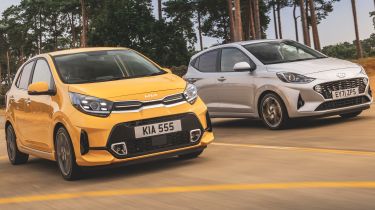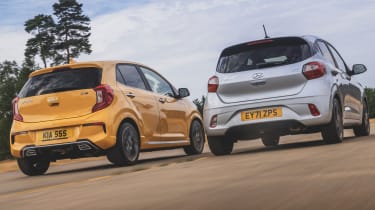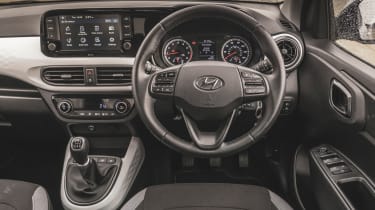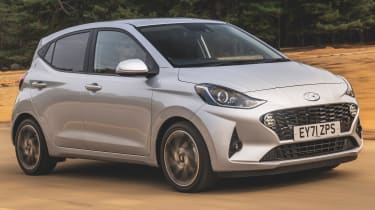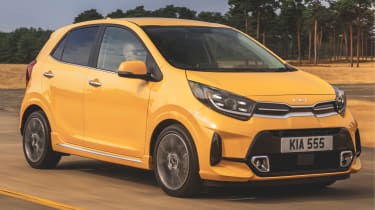Hyundai i10 vs Kia Picanto: 2022 twin test review
These city cars are at home in town or on the motorway, but which is best?
Kia and Hyundai have wowed us in recent times with show-stopping EVs and clever tech designs in traditional segments. They’re worthy distractions, but they shouldn’t take away from the fact that the brands’ cheaper, more pragmatic models are among the most underrated cars in their respective line-ups.
EVs offer zero tailpipe emissions, but there’s still very much a place for compact, efficient city cars, too. Both the Hyundai i10 and Kia Picanto deliver a very grown-up experience with a small footprint.
Many of the similarly sized offerings from Kia and Hyundai derive their mechanicals from the same place; after all, it makes sense to make the most of economies of scale and share parts within the group where possible. And nowhere is that more important than in a segment which constantly faces a squeeze, because profits are hard to achieve with lower asking prices.
Kia’s Picanto was the first of this pair to launch in their current incarnations. Sales began in 2017, with the funky-looking competitor taking on the Volkswagen up! and Toyota Aygo. A subtle facelift in 2020 saw tweaks to the lights, grille and bumpers, while inside the infotainment screen increased in size from seven to eight inches.
Used - available now

2024 BMW
4 Series
4,012 milesAutomaticPetrol2.0L
Cash £31,600
2019 Toyota
Aygo
34,790 milesManualPetrol1.0L
Cash £7,963
2020 Mercedes
A-Class Saloon
73,171 milesAutomaticPetrol2.0L
Cash £15,863
2023 Tesla
New Model Y
54,220 milesAutomaticElectric
Cash £24,563The first thing that strikes you about our Picanto is just how much standard equipment you get. As standard, this top-spec GT Line S model has climate control, a touchscreen infotainment system, heated front seats and steering wheel, plus leather upholstery. Not too long ago an equipment list like that would be associated with a luxury saloon.
Then there’s the safety tech, which reads like that of a modern executive car. Forward collision avoidance assist, blind-spot collision avoidance assist, lane-keeping assist, and a driver-attention warning system all feature. There’s even lane-following assist, which can assume control of the vehicle’s steering, braking and throttle on the motorway.
These features are also offered on the Hyundai, a car that appears slightly more mature than the Kia. Its dash looks a little more modern, and its five-door body is spacious inside. There’s little to split the two for storage; the i10’s boot capacity is 252 litres to the Picanto’s 255 litres.
Driving
The pair continue to impress once you get behind the wheel. Both models have the joyful character that make city cars great. They’re tiny, agile and joyfully easy to whip into tight parking spaces or through small gaps.
Yet it’s the level of maturity that really stands out here. Both the Hyundai and Kia are fairly refined at a cruise, and neither would leave you even thinking twice about covering some long motorway miles. However, the i10 has the edge on the open road, offering just a little more ride comfort and a touch more refinement than the Picanto.
Despite the cars’ mechanical similarities, it’s the engines which provide the key difference, though. The Kia is offered with 1.0-litre three-cylinder units only, both with a turbo for a lively 99bhp output, or without for 66bhp.
The i10 comes with both of those motors, but also a 83bhp 1.2-litre four cylinder. Of those options, it’s the one we’d have, because it’s more refined and a little more easy to drive smoothly than the more powerful turbocharged triple. The 1.2-litre unit does have less torque than the turbo engine, though, so if you will be regularly making use of those back seats with extra passengers, then the turbocharged model will still be worth a look.
Place a £2,000 deposit on a three-year PCP agreement for our pick of the Hyundai range, the i10 1.2 Premium, and the monthly payments come to £255. The Picanto ‘3’ comes to £237 per month on matching terms, but it comes with the less powerful 1.0-litre triple-cylinder engine. For the extra power and refinement you’re getting, we’d stretch to the Hyundai if your finances allow it.
Verdict
First place: Hyundai i10
The third-generation i10 hit the ground running in the city-car segment. There really is very little to find fault with; it’s great to drive in town, yet has the maturity to be just at home on a long trip. The engine line-up is more varied than the Picanto’s, and there’s very little to separate the two when it comes to space, equipment levels or finances.
Second place: Kia Picanto
It takes second here, but the Picanto’s sense of fun still shines through. It’s great to drive, is packed with standard kit and has plenty of space inside. The engine range has a key gap between the underpowered entry-level models and the range-topping GT-Line S, though, and this is one of the key reasons the Kia can’t quite win this round.
Figures
|
Hyundai i10 1.2 MPi Premium |
Kia Picanto 1.0 T-GDi GT-Line S | |
|
On the road price |
£16,480 |
£17.05 |
|
Residual value (after 3yrs/36,000) |
£8,476/51.4% |
£8,274/48.5% |
|
Annual tax liability std/higher rate |
£942/£1,883 |
£975/£1,949 |
|
Insurance group/quote/road tax cost |
8/£375/£165 |
11/£359/£165 |
|
Servicing costs |
£578 (3 years) |
£429 (3 years) |
|
Length/wheelbase |
3,670/2,425mm |
3,670/2,400mm |
|
Height/width |
1,480/1,680mm |
1,500/1,625mm |
|
Engine |
4cyl in-line/1,248cc |
3cyl turbo/998cc |
|
Peak power |
83/6,000 bhp/rpm |
99/4,500 bhp/rpm |
|
Peak torque |
118/4,200 Nm/rpm |
172/1,500 Nm/rpm |
|
Transmission |
5-speed man/FWD |
5-speed man/FWD |
|
Fuel tank capacity/spare wheel |
36 litres/repair kit |
35 litres/repair kit |
|
Boot capacity (seats up/down) |
252/1,050 litres |
255/1,010 litres |
|
Kerbweight |
932kg |
981kg |
|
Turning circle |
9.6 metres |
9.4 metres |
|
Basic warranty (miles) |
5yrs (unlimited)/1yr |
7yrs (100,000)/1yr |
|
NCAP: Adult/child/ped./assist/stars |
69/75/52/59/3 (2020) |
87/64/54/47/4 (2017) |
|
Driver Power manufacturer/dealer pos. |
11th/12th |
3rd/5th |
|
0-62mph |
12.6 secs |
9.9 secs |
|
Top Speed |
106mph |
112mph |
|
WLTP mpg |
51.4mpg |
53.3mpg |
|
Claimed CO2/tax bracket |
124g/km/29% |
120g/km/29% |
Now read our twin test of the Hyundai Ioniq 5 and Kia EV6...
